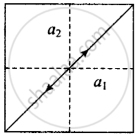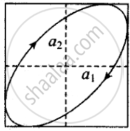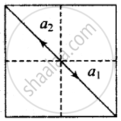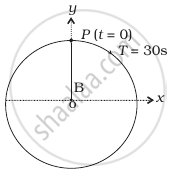Advertisements
Advertisements
प्रश्न
A particle is acted simultaneously by mutually perpendicular simple harmonic motions x = a cos ωt and y = a sin ωt. The trajectory of motion of the particle will be ______.
विकल्प
an ellipse.
a parabola.
a circle.
a straight line.
उत्तर
A particle is acted simultaneously by mutually perpendicular simple harmonic motions x = a cos ωt and y = a sin ωt. The trajectory of motion of the particle will be a circle.
Explanation:
If two S.H.M act in perpendicular directions, then their resultant motion is in the form of a straight line or a circle or a parabola etc. depending on the frequency ratio of the two S.H.Ms and initial phase difference. These figures are called Lissajous figures.
Let the equations of two mutually perpendicular S.H.M of the same frequency be x = a1 sin ωt and y = a2 sin(ωt + Φ)
Then the general equation of the Lissajous figure can be obtained as `x^2/a_1^2 + y^2/a_2^2 - (2xy)/(a_1a_2) cos phi = sin^2 phi`

For `phi = 0^circ: x^2/a_1^2 + y^2/a_2^2 - (2xy)/(a_1a_2)` = 0
⇒ `(x/a_1 - y/a_2)^2` = 0
⇒ `x/a_1 = y/a_2`
⇒ `y = a_2/a_1 x`
This is a straight line which passes through the origin and its slope is `a_2/a_1`.
Lissajous figures in other conditions `("with" ω_1/ω_2 = 1)`
| Phase diff.(`phi)` | Equation | Figure |
| `pi/4` | `x^2/a_1^2 + y^2/a_2^2 - (sqrt(2)xy)/(a_1a_2) = 1/2` | Oblique ellipse |
| `pi/2` | `x^2/a_1^2 + y^2/a_2^2 = 1` |  |
| `pi` |
`x/a_1 + y/a_2` = 0 ⇒ `y = - a_2/a_1 x` |
Straight line |
We have to find the resultant displacement by adding x and y-components. According to the variation of x and y, the trajectory will be predicted.
Given, `x = a cos ωt = a sin(ωt + pi/2)` ......(i)
And `y = a sin ωt` ......(ii)
Here `a_1 = a_2 = a` and `phi = pi/2`
The trajectory of motion of the particle will be a circle of radius a.
APPEARS IN
संबंधित प्रश्न
Figures correspond to two circular motions. The radius of the circle, the period of revolution, the initial position, and the sense of revolution (i.e. clockwise or anti-clockwise) are indicated on each figure

Obtain the corresponding simple harmonic motions of the x-projection of the radius vector of the revolving particle P, in each case.
Figure (a) shows a spring of force constant k clamped rigidly at one end and a mass m attached to its free end. A force F applied at the free end stretches the spring. Figure (b) shows the same spring with both ends free and attached to a mass mat either end. Each end of the spring in Fig. (b) is stretched by the same force F.

(a) What is the maximum extension of the spring in the two cases?
(b) If the mass in Fig. (a) and the two masses in Fig. (b) are released, what is the period of oscillation in each case?
Which of the following functions of time represent (a) simple harmonic, (b) periodic but not simple harmonic, and (c) non-periodic motion? Give period for each case of periodic motion (ω is any positive constant):
sin ωt – cos ωt
Which of the following functions of time represent (a) simple harmonic, (b) periodic but not simple harmonic, and (c) non-periodic motion? Give period for each case of periodic motion (ω is any positive constant):
sin3 ωt
Which of the following functions of time represent (a) simple harmonic, (b) periodic but not simple harmonic, and (c) non-periodic motion? Give period for each case of periodic motion (ω is any positive constant):
3 cos `(π/4 – 2ω"t")`
Which of the following functions of time represent (a) simple harmonic, (b) periodic but not simple harmonic, and (c) non-periodic motion? Give period for each case of periodic motion (ω is any positive constant):
cos ωt + cos 3ωt + cos 5ωt
Which of the following functions of time represent (a) simple harmonic, (b) periodic but not simple harmonic, and (c) non-periodic motion? Give period for each case of periodic motion (ω is any positive constant):
exp (–ω2t2)
Figure shows the circular motion of a particle. The radius of the circle, the period, sense of revolution and the initial position are indicated on the figure. The simple harmonic motion of the x-projection of the radius vector of the rotating particle P is ______.

The rotation of earth about its axis is ______.
- periodic motion.
- simple harmonic motion.
- periodic but not simple harmonic motion.
- non-periodic motion.
A particle is in linear simple harmonic motion between two points A and B, 10 cm apart (Figure). Take the direction from A to B as the + ve direction and choose the correct statements.

- The sign of velocity, acceleration and force on the particle when it is 3 cm away from A going towards B are positive.
- The sign of velocity of the particle at C going towards O is negative.
- The sign of velocity, acceleration and force on the particle when it is 4 cm away from B going towards A are negative.
- The sign of acceleration and force on the particle when it is at point B is negative.
